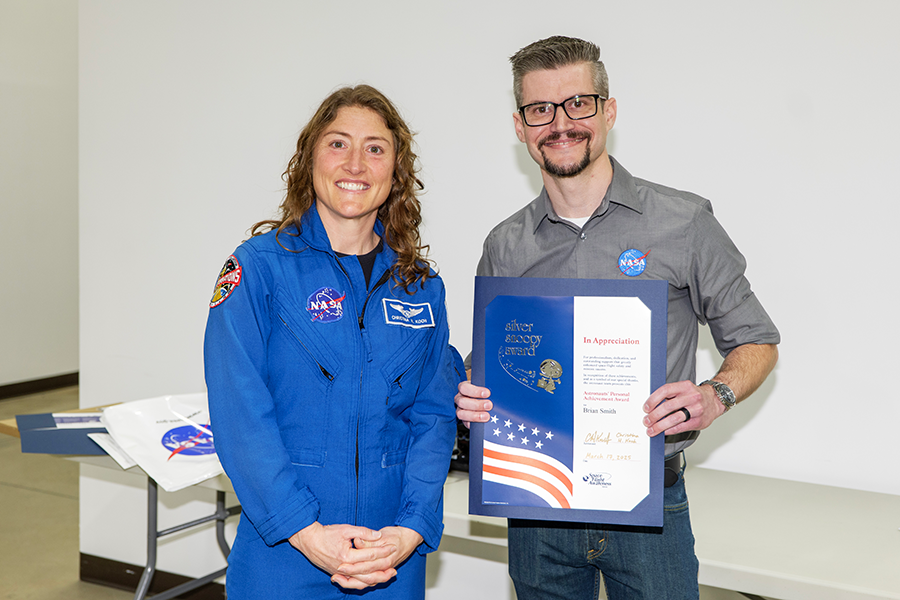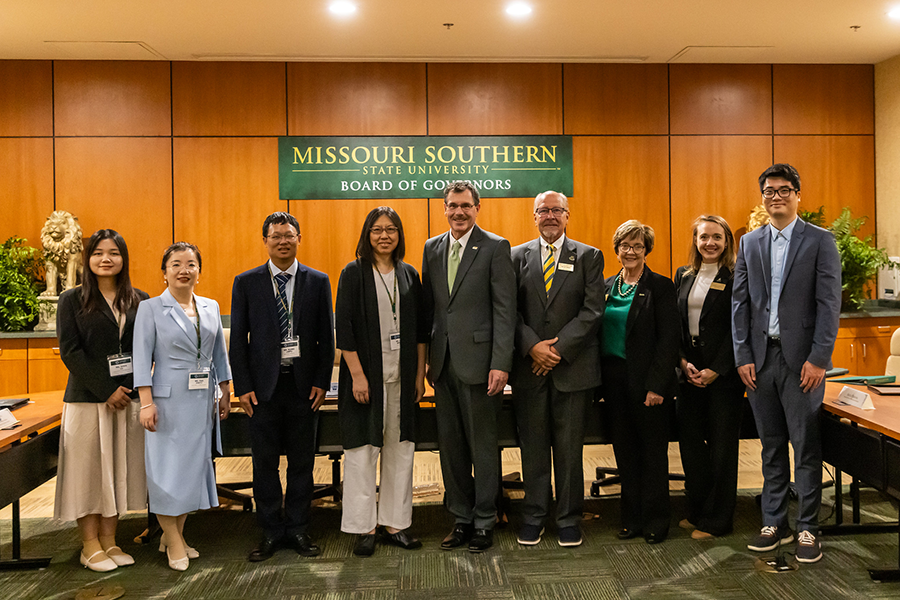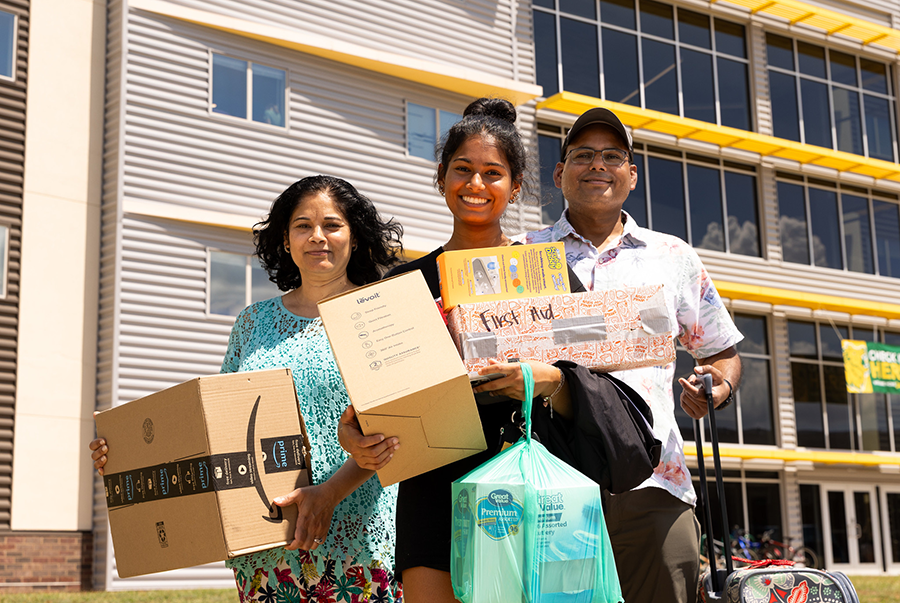On Brian Smith’s ’10, living room wall, next to a July 21, 1969, issue of “New York Daily News” hangs a personalized portrait signed by all four crew members of Artemis II, the first crewed flight of the Space Launch System and the Orion spacecraft around the Moon, set to launch in April 2026. Reid Wiseman, mission commander for the flight, gave Smith and his EaglePicher Technologies team members this gift last May.
“The fact that NASA would send an astronaut to visit our facility and meet our team really highlighted the importance of what we do here in Joplin to support their key missions,” Smith, a data analytics graduate student, relayed.
This wouldn’t be the only gift Smith would receive from Wiseman.
This March, Smith received an out-of-this-world honor: the Silver Snoopy, a small sterling silver pin featuring the “Peanuts” character Snoopy depicted as an astronaut, thrilled to visit the cosmos—which is exactly what it has done.
“The Silver Snoopy pin has flown in space,” Smith explains. “In the 1960s, NASA wanted to find a well-known and well-loved mascot for this safety promotion, and ‘Peanuts’ creator Charles Schulz welcomed the idea of using Snoopy, even designing the character in a spacesuit. His drawing is used as the award today.”
A special honor given to NASA employees and contractors for exceptional achievements related to human space flight safety or mission success, the Silver Snoopy is highly prestigious—fewer than one percent of the aerospace workforce earns it, and an individual may receive the award only once in their lifetime.
Smith, a manufacturing engineer at EaglePicher Technologies, was nominated for the Silver Snoopy by Wiseman and the entire Artemis II crew for his work as manufacturing engineer on the Orion spacecraft. While testing the small cell battery design for the mission, an issue was identified, one that could have led to loss of crew if an ascent abort was needed.
“Smith helped pinpoint the cause of the failure by walking the team through the specific details of the Orion battery construction,” Wiseman, mission commander for Artemis II, wrote in his nomination letter. “He was also critical in the identification and validation of the proposed fix.”
A Webb City native, Smith began his career working as a machine operator in a local machine shop completing his bachelor’s in industrial engineering technology at Missouri Southern. He became the Operations Manager at the same company after graduation. Deciding he wanted to transition into a role that better utilized his degree, Smith joined EaglePicher Technologies as a Manufacturing Engineer in 2017. Two years later, he began working full-time on the Orion program. His team was responsible for building the batteries for the Orion spacecraft for NASA’s Artemis II mission.
“The batteries are a mission-critical piece of hardware, powering the life support systems and providing electrical functionality to the spacecraft,” Smith explained. “While the electrical systems can run on solar power for much of the mission duration, the batteries are the sole source of electrical power during a potential launch abort sequence, as well as through reentry and splashdown at the end of a nominal mission. Artemis II will utilize the SLS rocket and Orion spacecraft to take humans out of low Earth orbit and around the Moon for the first time since the Apollo program ended in 1972. It is scheduled to launch in early 2026.”
During testing, Smith led the production team to efficiently produce prototype battery packs with design changes to be tested at the Johnson Space Center in Houston, Texas. To perform this effectively, the team invented new procedures to address deficiencies from the original build. Smith performed much of the effort himself.
“When a repair approach was identified, the production team became the critical path to getting the repaired batteries back on the Artemis II spacecraft,” Wiseman wrote. “Smith was invaluable in helping identify schedule savings that reduced the initial schedule estimates by more than six months, and he continually worked to identify ways to improve the schedule as the team juggled four flight batteries, a new qualification unit, and a spare.”
Smith maintained an encouraging approach throughout the entire process, always taking the time to verify that details were communicated and potential ramifications were understood.
The Silver Snoopy is always presented by an astronaut at the recipient’s place of work. A group from NASA including astronaut and Artemis II Mission Specialist Christina Koch and Orion Program Manager Howard Hu visited EaglePicher Technologies on March 17 to personally thank the team for their efforts in support of the program—and to pin Smith with the Silver Snoopy.
“It’s difficult to put into words what this award means to me,” said Smith. “I certainly never thought I would receive a Silver Snoopy, so I was blown away when I heard. We do what we do for mission success and astronaut safety, not for personal recognition. To be recognized by a member of the crew who would ultimately depend on our batteries in space was an incredibly moving experience.”
Smith will graduate with his master’s in data analytics from MSSU this spring. His wife Briana, who works at the university as senior bursar associate, is one of his biggest supporters.
“I would like to thank Briana for her understanding as I worked many late nights and weekends and for supporting my wild idea to also pursue my master’s degree when spare time was already limited.”
He also recognizes and thanks his EaglePicher Technologies teammates who have invested countless hours and significant effort in support of the Orion program.
“Human spaceflight is a team effort, and success belongs to the entire team.”




